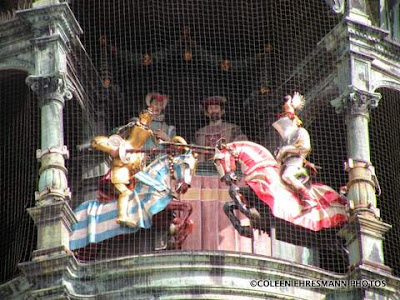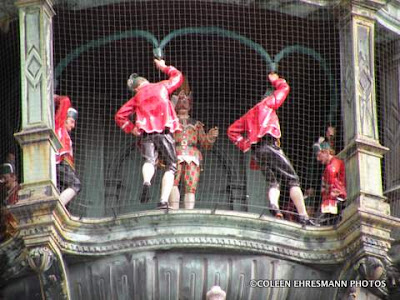
the plaza crowd at 10:00 AM

entertainers before the clock performance

hundreds of people with cameras and selfie-sticks in the plaza
waiting for the 11:00 AM Glockenspiel performance
Glockenspiel is also known as a carillon

the two levels of animated characters
'show' lasts 12-15 minutes depending on the song that is played
This chiming clock was added to the tower of the Neues Rathaus (New Town Hall) the year the building was completed in 1907.

top level is a wedding procession and plays first
The top level recounts the 1568 wedding of Duke Wilhelm V (1548-1626) and Renata of Lorraine (1544–1602), one of the most expensive and downright decadent weddings of the Middle Ages.
It was a huge dynastic deal, the Austrian archdukes arrived in a train of over 1500 horses and more than 600 oxen were carved and cooked up for the revellers.
On the day of the nuptials the bride was collected from the nearby town of Dachau by no less than 3500 mounted riders. The whole party lasted about two weeks.
The crowd highlight was the Kröndlstechen, or crown joust, which took place right on Marienplatz and is now a big part of the Glockenspiel show.
It was a huge dynastic deal, the Austrian archdukes arrived in a train of over 1500 horses and more than 600 oxen were carved and cooked up for the revellers.
On the day of the nuptials the bride was collected from the nearby town of Dachau by no less than 3500 mounted riders. The whole party lasted about two weeks.
The crowd highlight was the Kröndlstechen, or crown joust, which took place right on Marienplatz and is now a big part of the Glockenspiel show.

jousting knights pass twice

blue & white Bavarian knight jabbed the red knight on the second pass
The Munich Glockenspiel shows a Bavarian knight battling a French jouster and as you'd expect the Bavarian always wins.

musicians and dancers in the wedding procession

dancers on the second level
On the lower level you can see the red-coated city’s coopers (barrel makers) do a ritualistic jig known as the Schäfflertanz. The dance is popularly thought to have begun in the devastating plague year of 1517, but it actually dates back further. Legend says the coopers started the dance to give Munich’s residents the all-clear that the plague was done and dusted. The Bavarian duke Wilhelm IV ordered the dance be re-enacted every seven years to keep the deadly disease in the collective memory.

dancers twirl and pass at least twice
has 43 bells and 42 life-size dancers

geraniums in window boxes of the tower

statue on the left of the stage

statue on the right of the stage
We have 3 day trips scheduled for the middle of our stay. We get back rather late at night, so not certain when the blog post will happen.
No comments:
Post a Comment
Thanks for your comments!